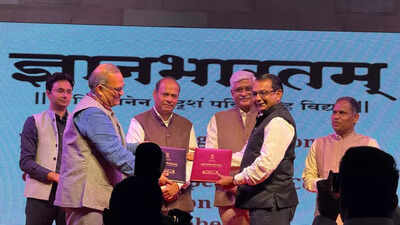ARTICLE AD BOX

The Asiatic Society in Kolkata has been designated a key cluster centre for Eastern India under the Union Culture Ministry's Gyan Bharatam Mission
KOLKATA: The Asiatic Society, Kolkata, one of India’s oldest centres of learning and Oriental research, has been formally designated as the key cluster centre for Eastern India under the Union Culture Ministry’s flagship Gyan Bharatam Mission on Manuscripts.
The move marks a decisive step towards preserving, digitising, and unlocking the wisdom encoded in thousands of ancient texts written in Sanskrit, Pali, Persian, Farsi, and other classical languages.Under a Memorandum of Understanding (MoU) signed recently in Delhi, the Ministry of Culture granted the Asiatic Society an initial allocation of Rs40 lakh to undertake the conservation, cataloguing, and digitisation of rare manuscripts.
The initiative aims to develop a comprehensive database of manuscripts across West Bengal and Eastern India and make their content accessible through a digital platform.“It is a very important project,” said Lt. Col. Anant Sinha, Administrator of the Asiatic Society. “Many manuscripts lie neglected in corners of Bengal and beyond. This project must be executed on a war footing before we lose those priceless pieces of wisdom.
Digitisation will help us understand their full extent and importance.”
Taking the effort a step further, the Asiatic Society is planning to integrate artificial intelligence (AI) and machine learning (ML) into its digitisation drive. A research centre is being proposed in collaboration with IIT-Kharagpur, IIT-Delhi, and the Centre for Development of Advanced Computing (CDAC) to develop advanced tools for transcription, translation, and digital reconstruction of manuscripts.“CDAC is working on transcribing ancient scripts, while hyperspectral imaging will help recover text from damaged or faded pages,” Sinha explained. “The IIT teams are developing algorithms for script recognition and translation.”The initiative has already drawn interest from institutions such as Calcutta University, Visva-Bharati, Burdwan University, State Archives, Victoria Memorial Hall, Kolkata Port Trust, and several regional libraries.
“Digitisation is only the first step,” said Sinha. “We will handhold these institutions through the next phases of transcription and translation so that the knowledge can reach students, researchers, and the wider public.
”Founded in 1784, the Asiatic Society holds over 50,000 manuscripts, many of them still undeciphered. As part of Gyan Bharatam, it will play a leading role in establishing the National Digital Repository (NDR) — a unified platform to share India’s manuscript heritage globally.The Gyan Bharatam Mission, announced in the Union Budget this year, seeks to identify, document, conserve, and promote India’s vast manuscript wealth. Institutions under the mission have been categorised as cluster centres and independent centres. Cluster centres like the Asiatic Society will oversee activities within their own archives and those of up to 20 partner institutions.The project encompasses surveying and cataloguing, conservation and capacity building, technology and digitisation, linguistics and translation, and research and outreach. Each centre will also form a dedicated Gyan Bharatam Cell to coordinate work across these domains.Funding will be released in two phases — 70% initially and the remaining 30% upon submission of progress and utilisation reports — ensuring accountability and adherence to milestones.Caption: Asiatic Society, Kolkata head Lt. Col Anant Sinha exchanging the MoU document in presence of the union minister of culture Gajendra Singh Shekhawat and culture secretary Vivek Aggarwal.

 2 hours ago
4
2 hours ago
4









 English (US) ·
English (US) ·